
This September 1862 photo provided by the Library of Congress shows Allan Pinkerton on horseback during the Battle of Antietam, near Sharpsburg, Maryland. Before the outbreak of war, he had founded the Pinkerton National Detective Agency. In 1861, he famously foiled an alleged plot to assassinate president-elect Lincoln, and later served as the head of the Union Intelligence Service — the forerunner of the U.S. Secret Service.
The Civil War was certainly the most catastrophic event in American history. More than 600,000 Northerners and Southerners died in the war, a greater number than all those who had died in all other American wars combined. (The other parts of these photo series: The American Civil War in pictures (part 2), 1861-1865; The American Civil War in pictures (part 3), 1861-1865.
As many as 50,000 died in a single battle. The high death toll particularly hurt the South, which had a smaller population going into the war.
Nearly every American lost someone in the war: a friend, relative, brother, son, or father. In fact, the war was so divisive that it split some families completely in two.
One U.S. senator, for example, had a son who served as a general in the Union army and another as a general for the Confederacy. Even the “Great Emancipator” Abraham Lincoln himself had four brothers-in-law who fought for the South.
As disastrous as the war was, however, it also brought the states—in the North as well as the South—closer together. After the war, the United States truly was united in every sense of the word.

Fort Sumter, South Carolina, April, 1861, under the Confederate flag. The first shots of the Civil War took place here, on April 12, 1861, as Confederate batteries opened fire on the Union fort, bombarding it for 34 straight hours. On April 13, Union forces surrendered and evacuated the fort. Union forces made many attempts to retake the fort throughout the war, but only took possession on February 22, 1865, after Confederate forces had evacuated Charleston.
Most obvious, the war ended the debate over slavery that had divided North and South since the drafting of the Constitution in 1787. States had bickered over Missouri, the Wilmot Proviso and the Mexican Cession, Texas, California, the Fugitive Slave Laws, Dred Scott v. Sanford, Bleeding Kansas, and John Brown and had still been unable to resolve the dispute.
In this sense, the Civil War had become inevitable once it was clear that compromises such as the three-fifths clause, the Missouri Compromise, and the Compromise of 1850 had little effect.
With each decade, the two regions had drifted further and further apart. Lincoln’s Emancipation Proclamation of 1863, however, ended the debate for good. Lincoln knew that only when slavery had been abolished would the debate end and the Union be reunited.
The Union victory also ended the debates over states’ rights versus federalism. Southerners and Democrats had believed since Thomas Jefferson’s and James Madison’s Virginia and Kentucky Resolutions that states had the right to overrule the federal government when Congress acted unconstitutionally.
In other words, they believed that states—not the Supreme Court—had the power of judicial review to determine whether Congress’s laws were constitutional or unconstitutional.

Yorktown, Virginia, Embarkation for White House Landing, Virginia, Photograph from the main eastern theater of war, the Peninsular Campaign, May-August 1862.
John C. Calhoun had raised this point in his South Carolina Exposition and Protest during the Nullification Crisis of the 1830s when he had urged his state to nullify the Tariff of Abominations.
Whigs and Republicans, on the other hand, generally believed the opposite—that only the Supreme Court had the power of judicial review and that it was the duty of the states to obey the Court. The South’s defeat asserted federal power over the states and settled the debate once and for all.
The Civil War was also a significant event in world history because the North’s victory proved that democracy worked. When war broke out in 1861, many monarchs in Europe had believed smugly that the United States was on the brink of collapse. Democracy, they argued, was too volatile, too messy, and too fragile to be of any practical use.
Lincoln himself recognized the historical significance of the war even before it was over. In his Gettysburg Address, he argued that the Civil War was a test for democracy and that the outcome of the war would determine the fate of representative government for the entire world. In his words, “…we here highly resolve…that government of the people, by the people, for the people, shall not perish from the earth”.

A captured Confederate encampment near Petersburg, Virginia, in June of 1864.

A view of Washington, District of Columbia, from the intersection of 3rd and Indiana Avenue, ca. 1863. In the foreground is Trinity Episcopal Church, in the background, the unfinished Capitol building. Construction on the capitol was briefly suspended early in the war, but continued through the later years.
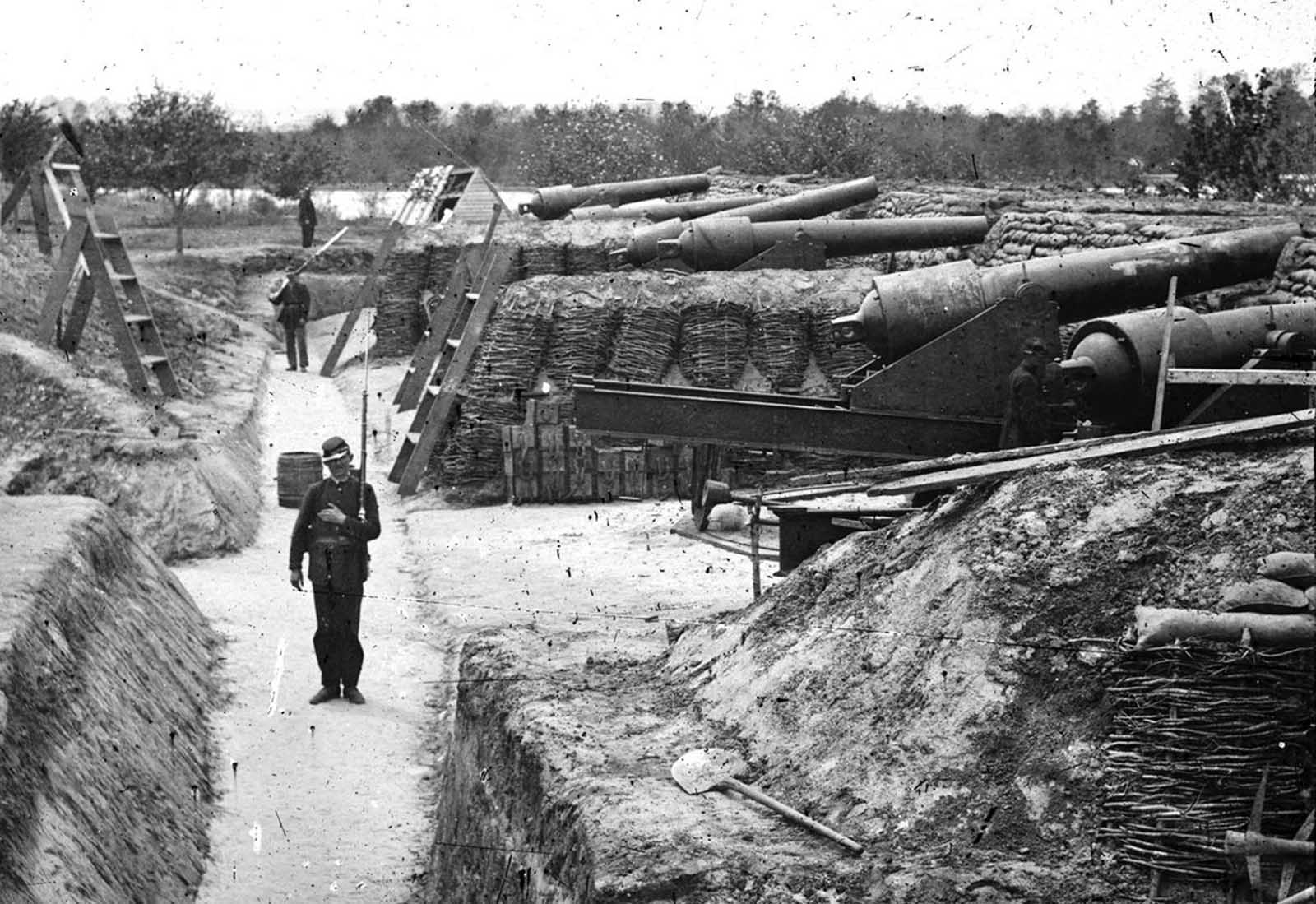
Fortifications at Yorktown, Virginia, during the Peninsula Campaign of 1862.
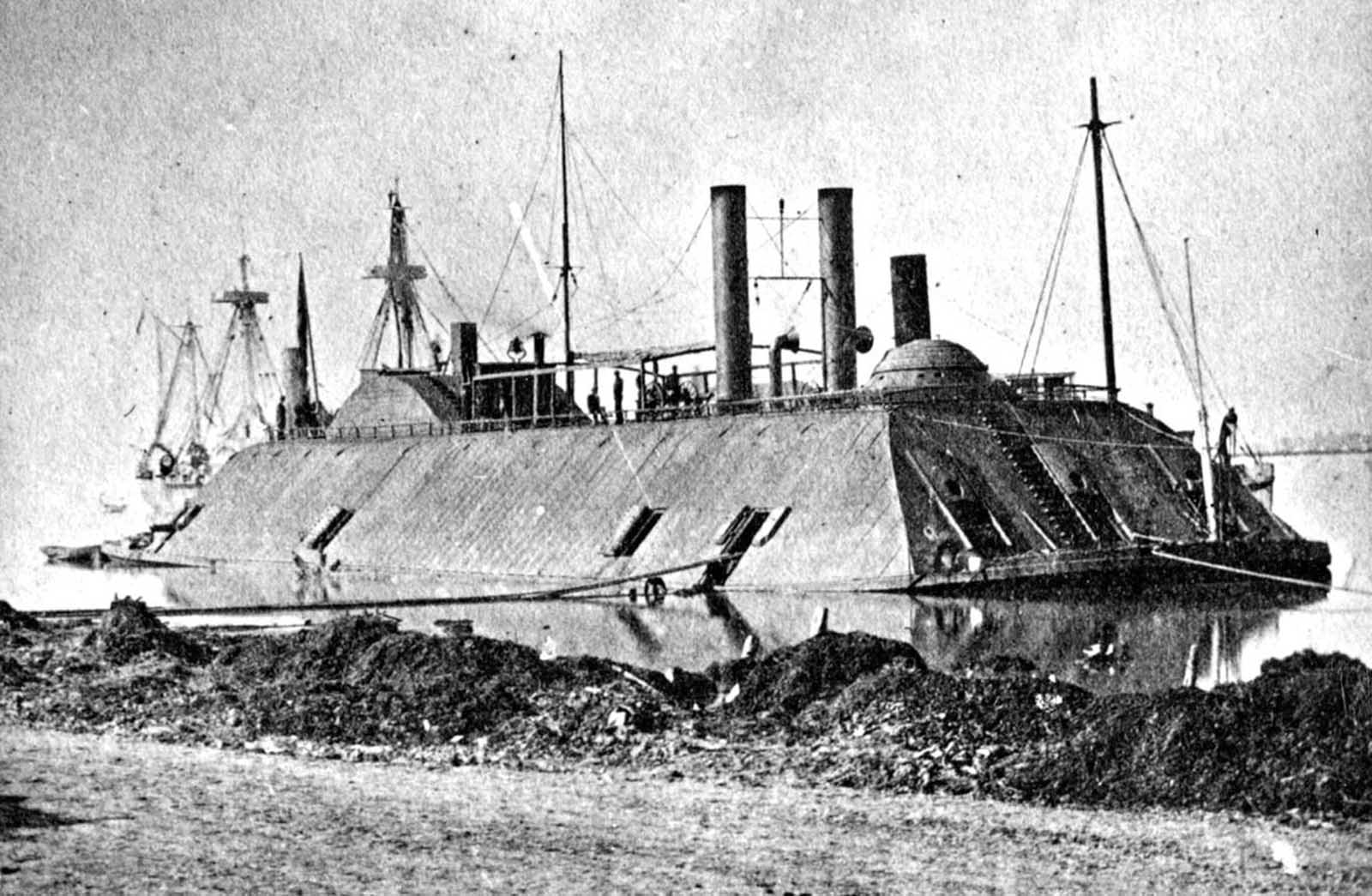
A March, 1863 photo of the USS Essex. The 1000-ton ironclad river gunboat, originally a steam-powered ferry, was acquired during the American Civil War by the US Army in 1861 for the Western Gunboat Flotilla. She was transferred to the US Navy in 1862 and participated in several operations on the Mississippi River, including the capture of Baton Rouge and Port Hudson in 1863.
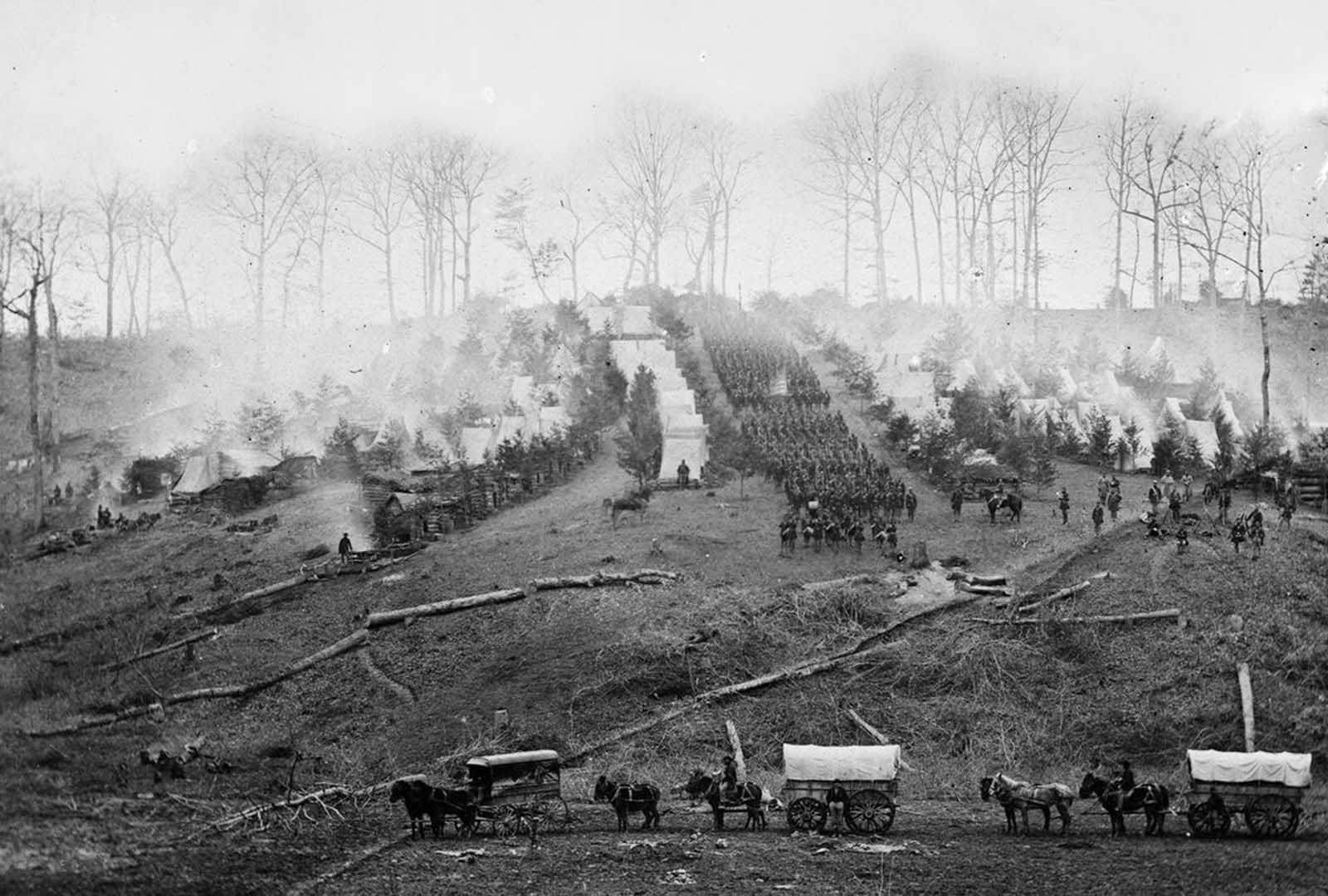
The 150th Pennsylvania Infantry camp on Belle Plain, Virginia, is pictured in March 1862, three weeks before the Battle of Chancellorsville.
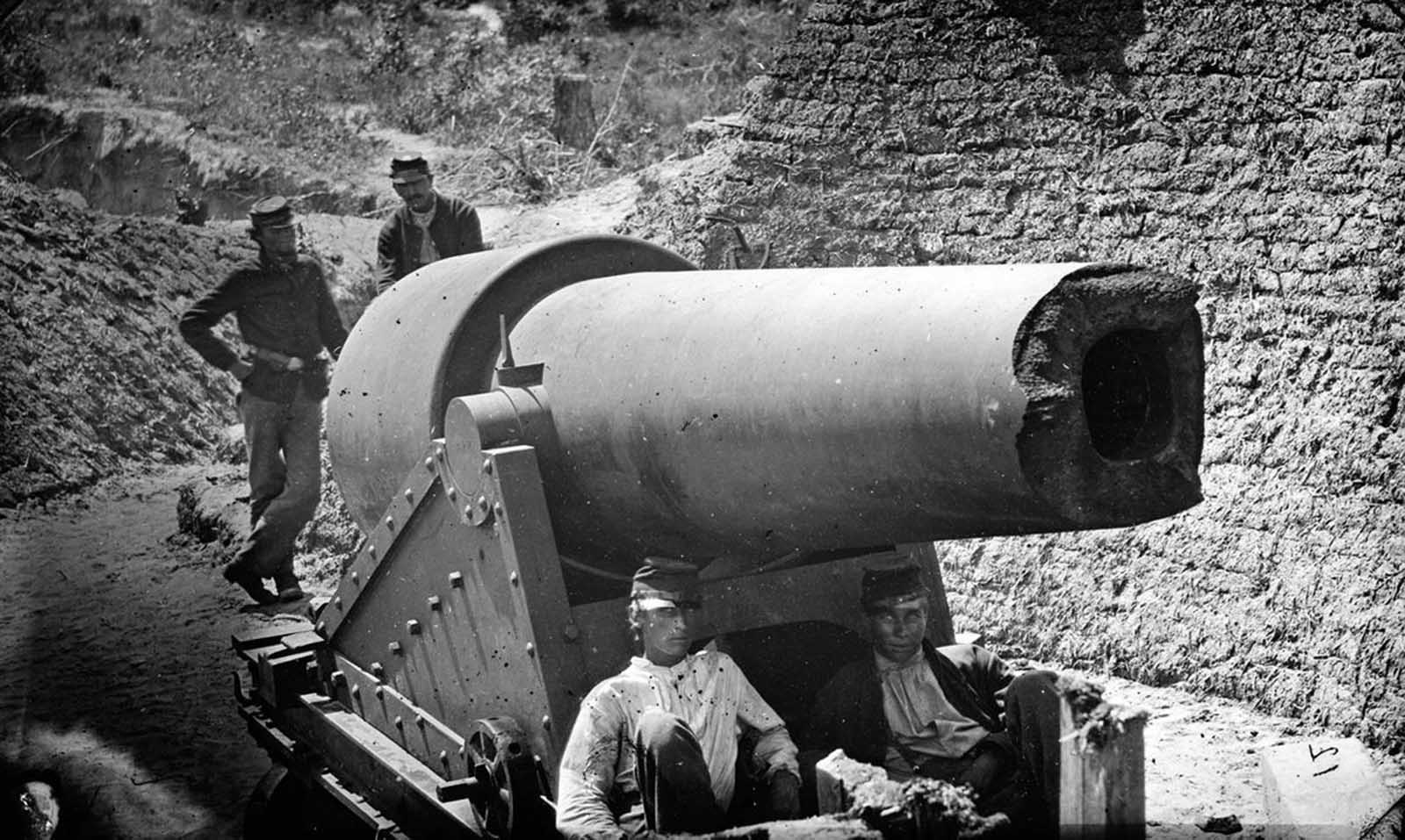
Morris Island, South Carolina. The shattered muzzle of a 300-pounder Parrott Rifle after it had burst, photographed in July or August of 1863.

On the steps of the Tennessee State Capitol building in Nashville, Tennessee, with covered guns (lower right) set up nearby, in 1864.
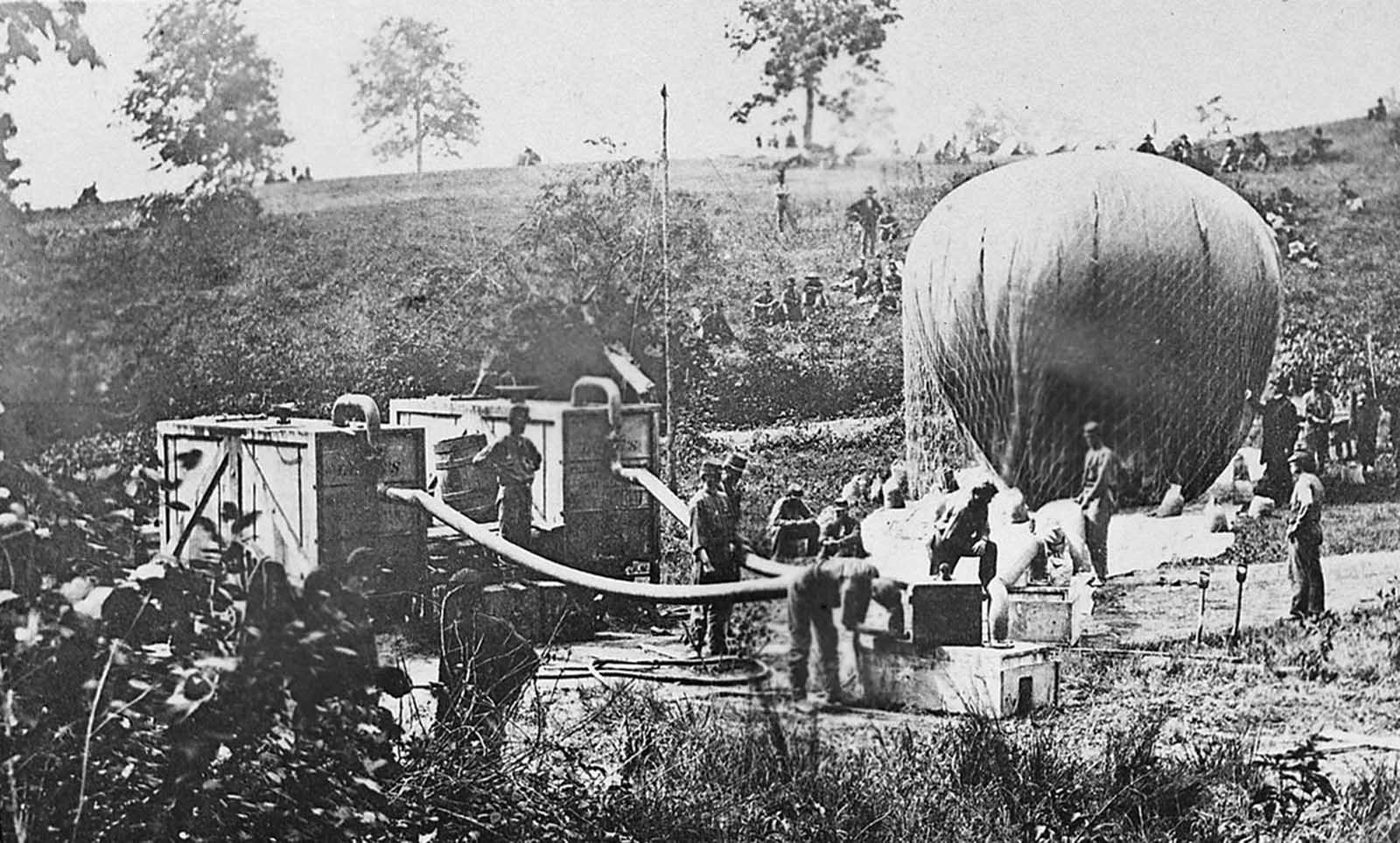
nflation of the Intrepid, a hydrogen gas balloon used by the Union Army Balloon Corps for aerial reconnaissance. The the Balloon Corps operated a total of seven balloons, with the Intrepid being favored by Chief Aeronaut Thaddeus Lowe.
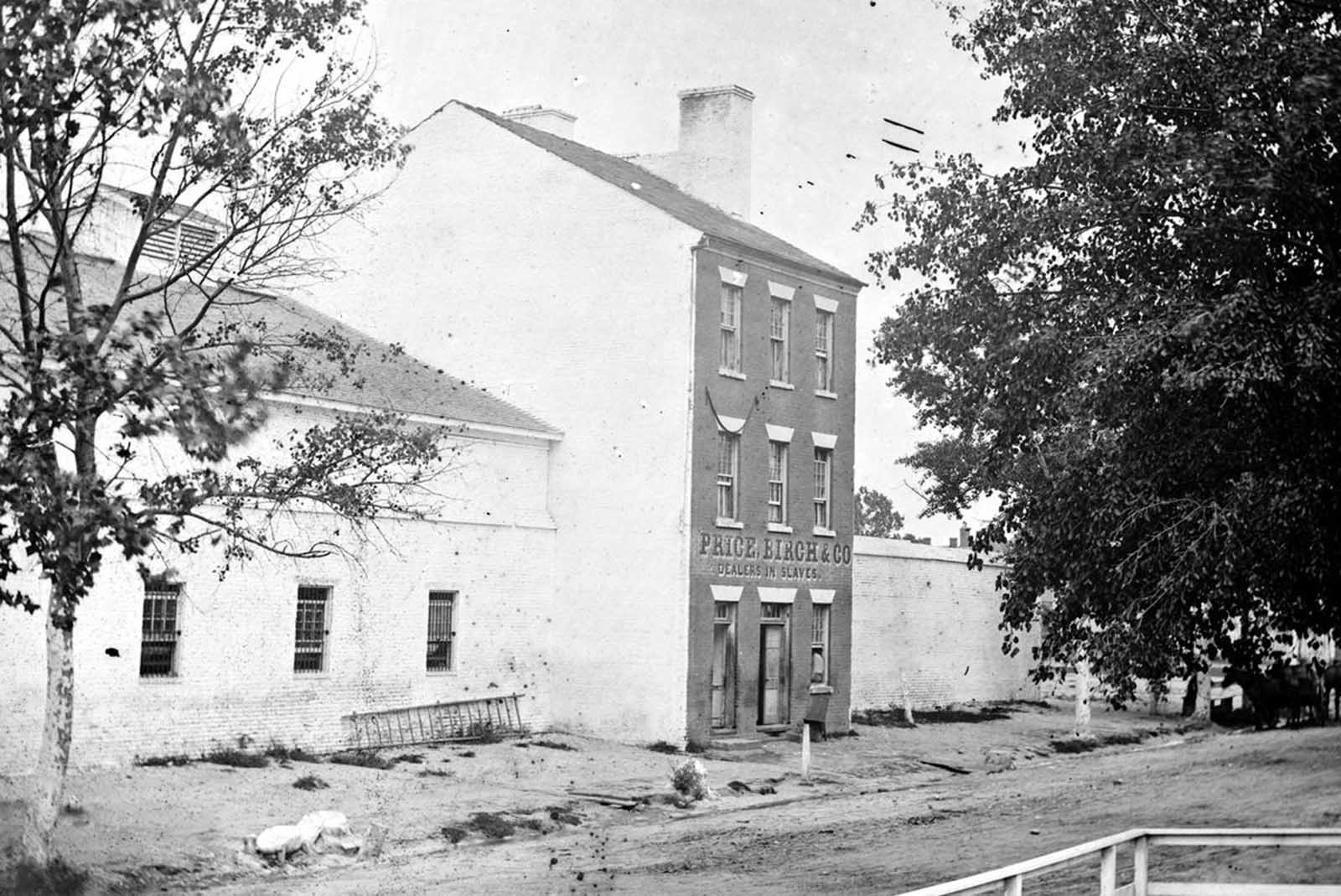
A scene in Alexandria, Virginia, in August of 1863. The storefront of 283 Duke St. reads “Price, Birch & Co., dealers in slaves”.
Stacked cannon balls, possibly a view of an arsenal yard in Washington, District of Columbia.
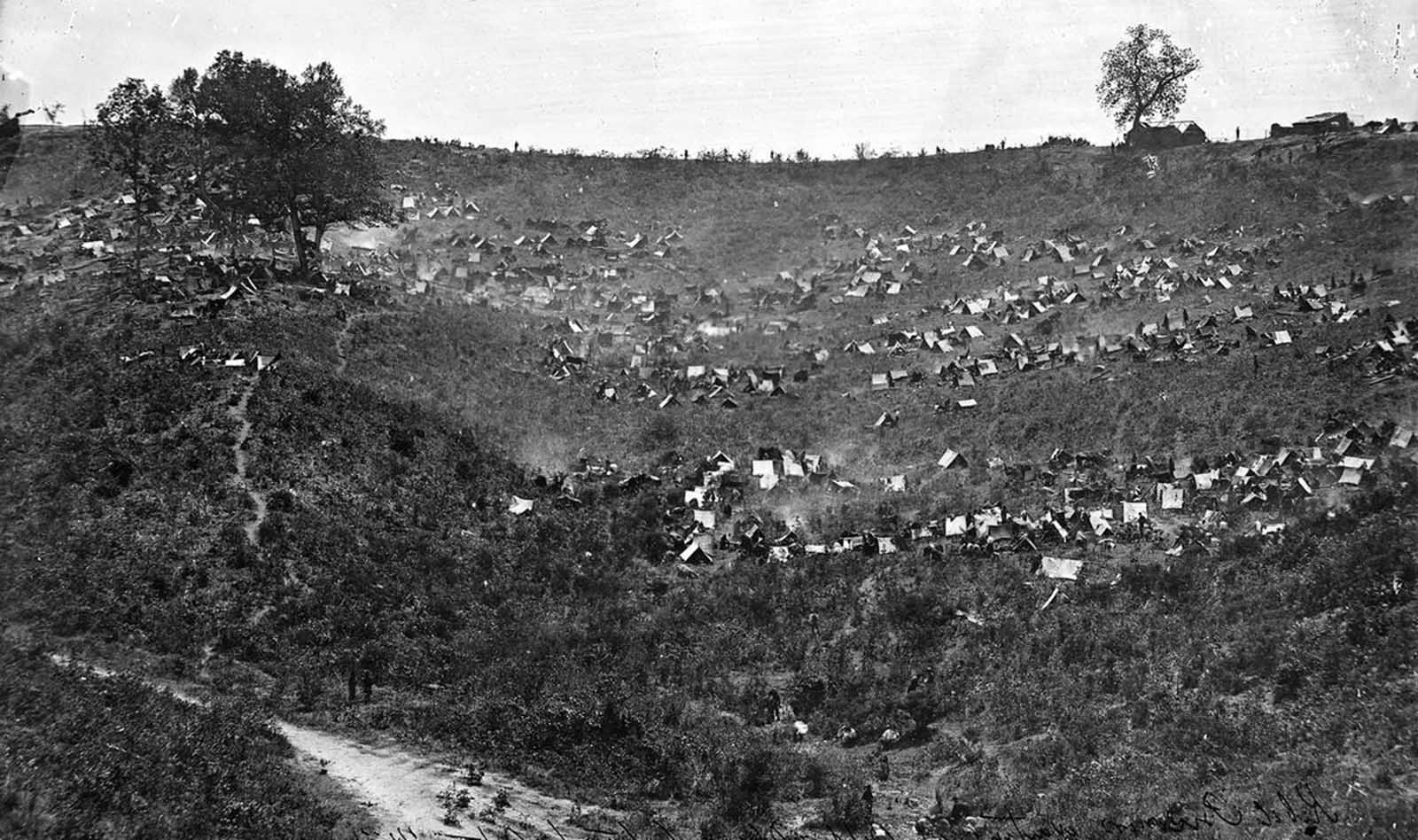
Rebel prisoners waiting at Belle Plain, Virginia, for transportation.

Wounded soldiers at rest near Marye’s Heights, Fredericksburg, Virginia. After the battle of Spotsylvania, in 1864.
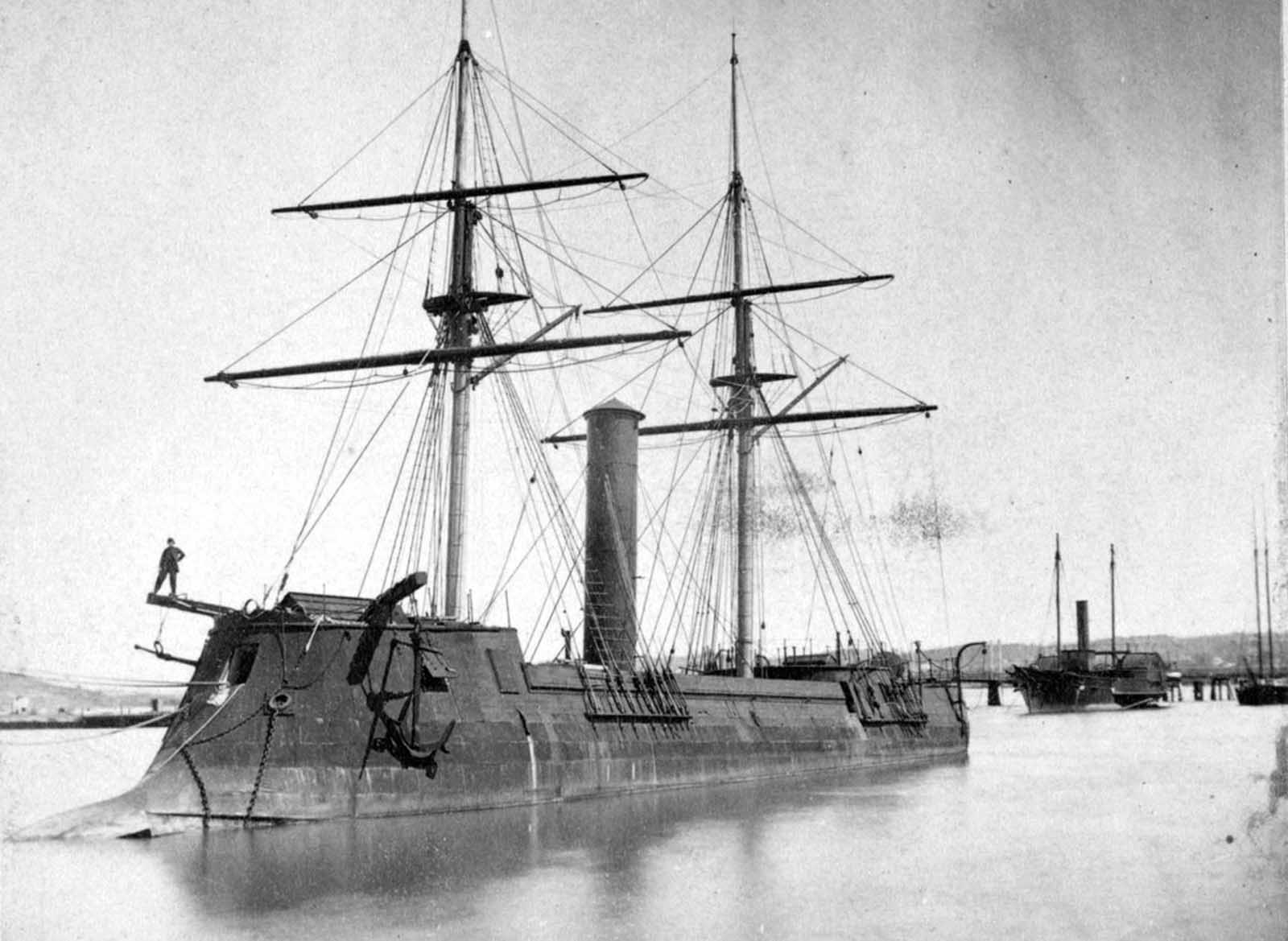
The CSS Stonewall was a 1,390-ton ironclad built in Bordeaux, France, for the Confederate Navy in 1864. After she crossed the Atlantic, reaching Havana, Cuba, it was already May, 1865, and the war had ended. Spanish Authorities took possession, soon handing it over to the U.S. government.
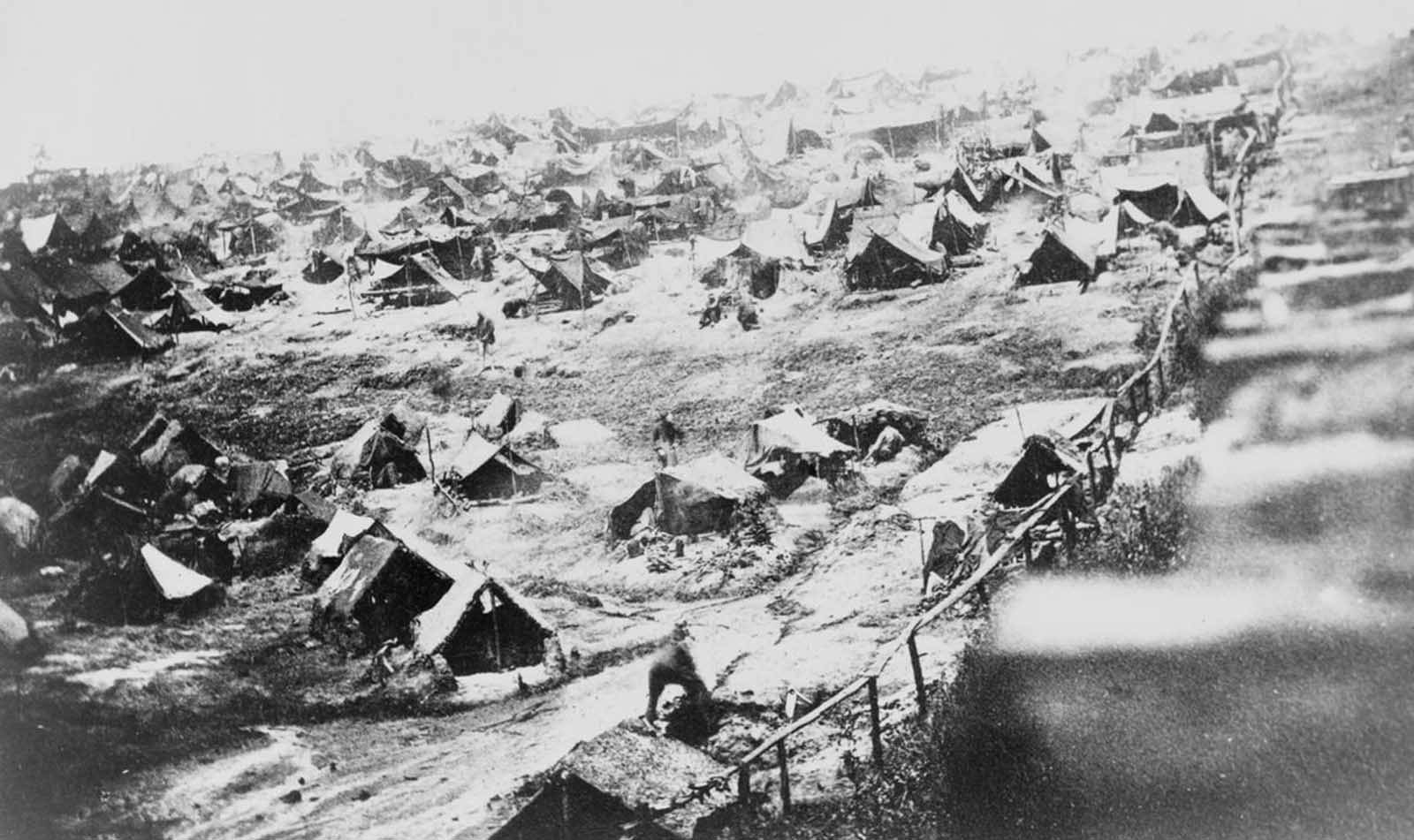
A view of Andersonville Prison, Georgia, on August 17, 1864. Andersonville was an infamous Confederate Prisoner-of-war camp, where nearly 13,000 of its approximately 45,000 Union prisoners died in brutal conditions, suffering from starvation, disease, and abuse from their captors.

Union prisoners draw their rations in this view from main gate of Andersonville Prison, Georgia, on August 17, 1864.

Dead horses surround the damaged Trostle House, results of the Battle of Gettysburg, in July of 1863. Union general Major General Daniel Sickles used the farmhouse as a headquarters and Union and Confederate troops fought among the farm buildings during the fierce battle.

An execution in Washington, District of Columbia, on November 10, 1865. Henry Wirz, former commander of the Confederate prisoner of war camp near Andersonville, Georgia, was tried and hung after the war for conspiracy and murder related to his command of the notorious camp.

African Americans prepare cotton for a cotton gin on Smith’s plantation, Port Royal Island, South Carolina, in 1862.
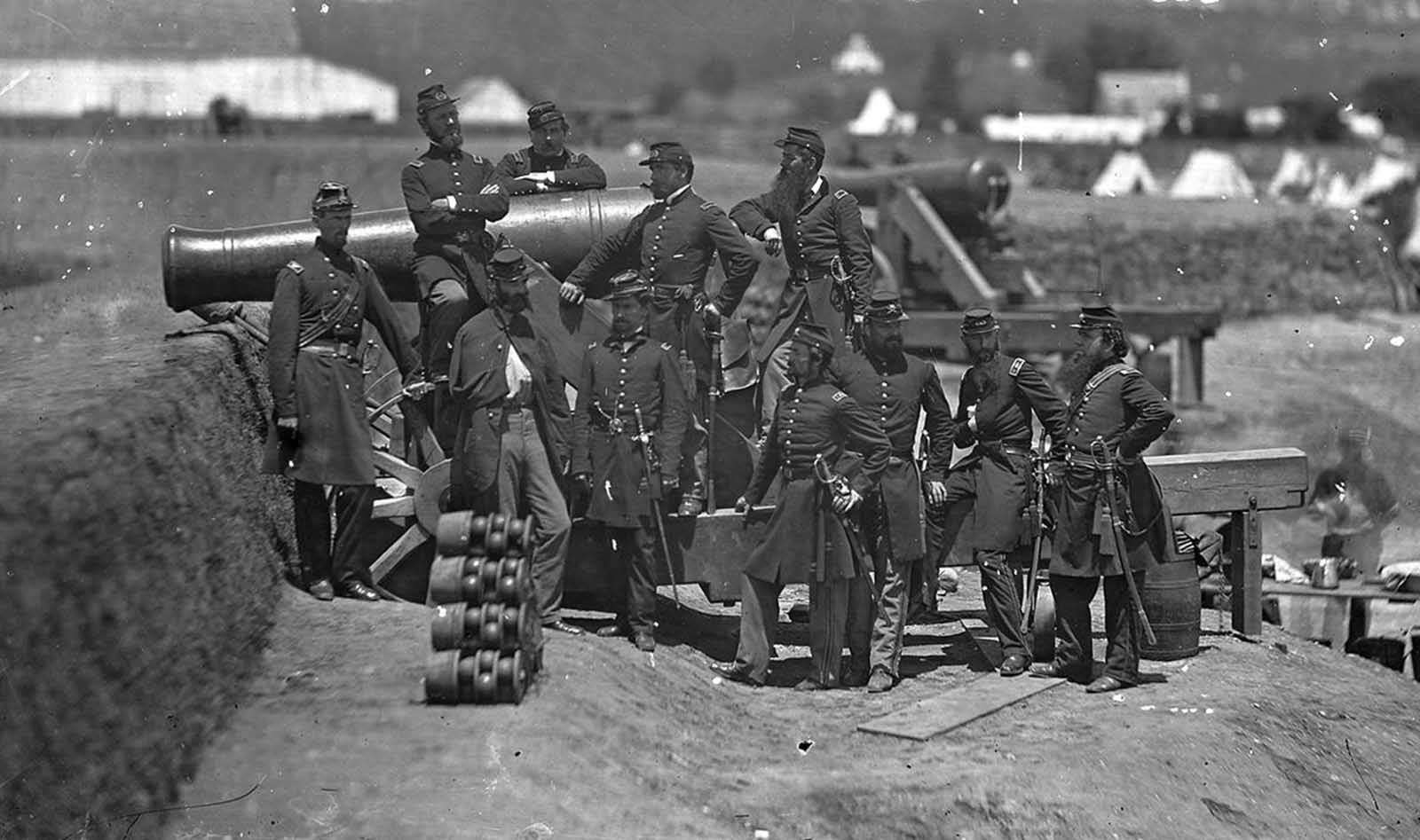
Officers of the 69th Infantry New York, at Fort Corcoran, Virginia, with Col. Michael Corcoran.

A Federal encampment on the Pamunkey River, Cumberland Landing, Virginia, in May of 1862.
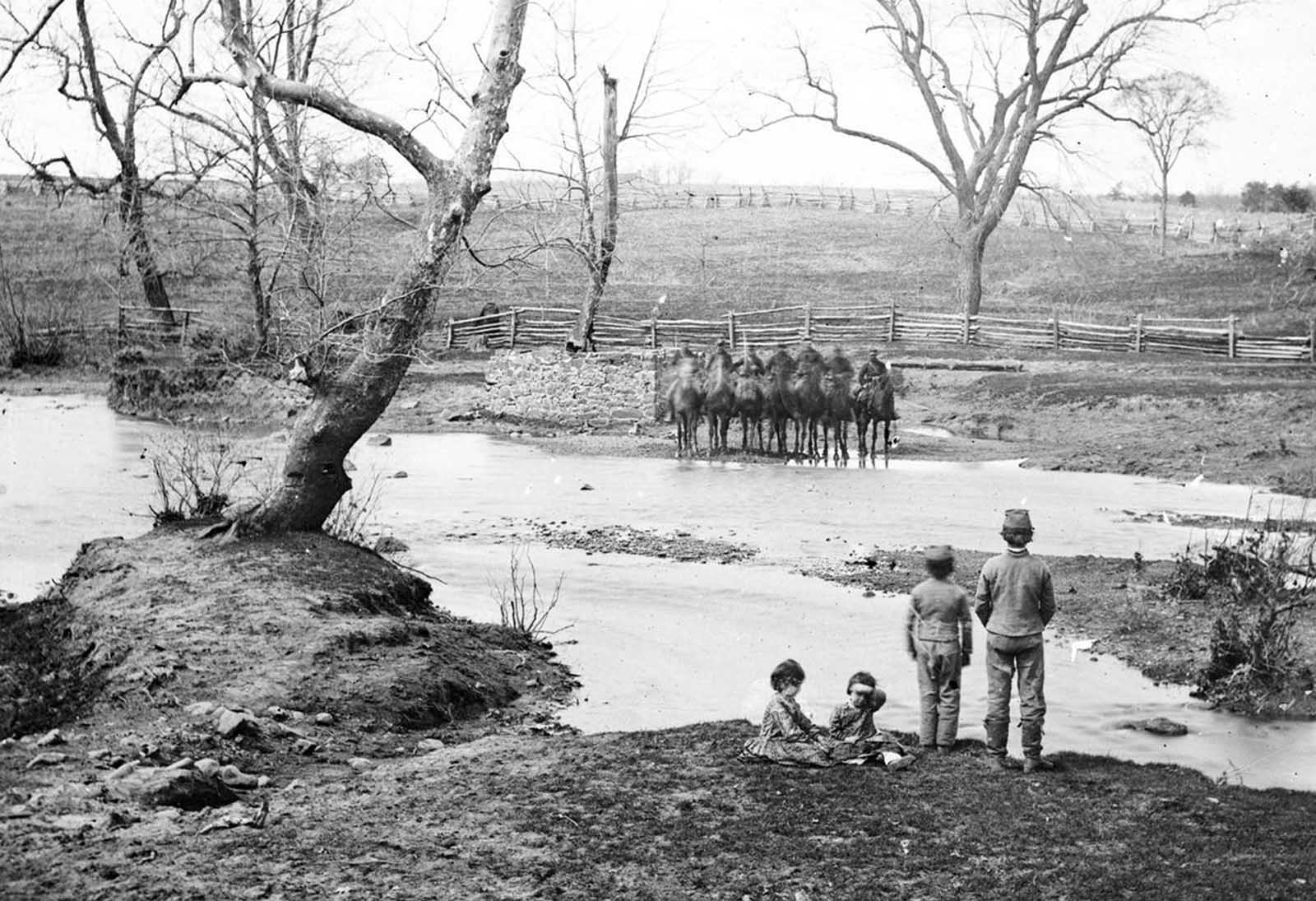
Federal cavalry at Sudley Ford, Virginia, following the battle of First Bull Run, in March of 1862.
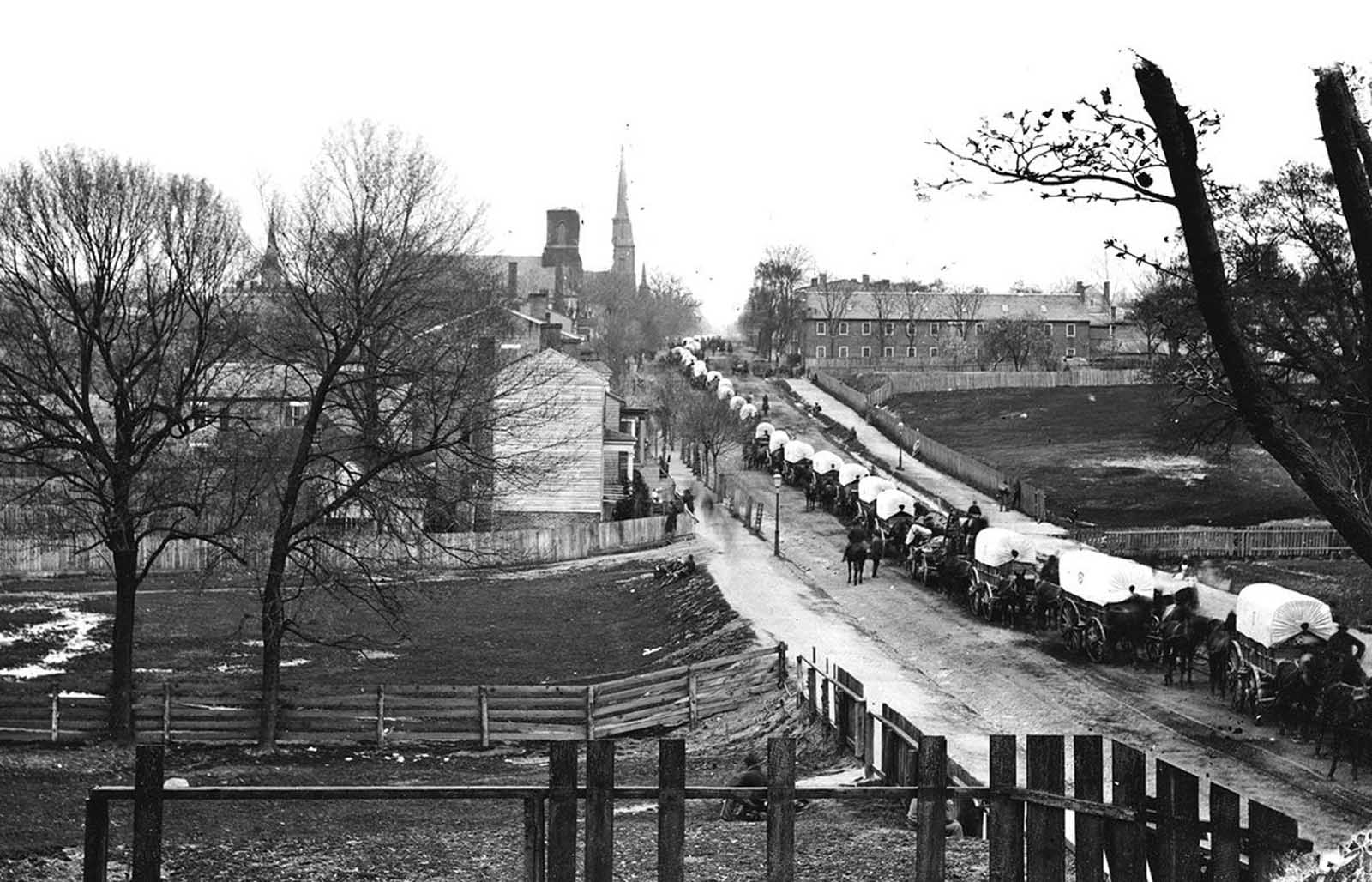
Petersburg, Virginia, the first Federal army wagon train entering the town in April of 1865.

Union forces of Benson’s Battery in the Battle of Seven Pines stand guard in the fighting against Gen. Thomas “Stonewall” Jackson’s Confederate troops at Fair Oaks, near Richmond, Virginia. The battle, also called Fair Oaks, took place on May 31 and June 1, 1862.
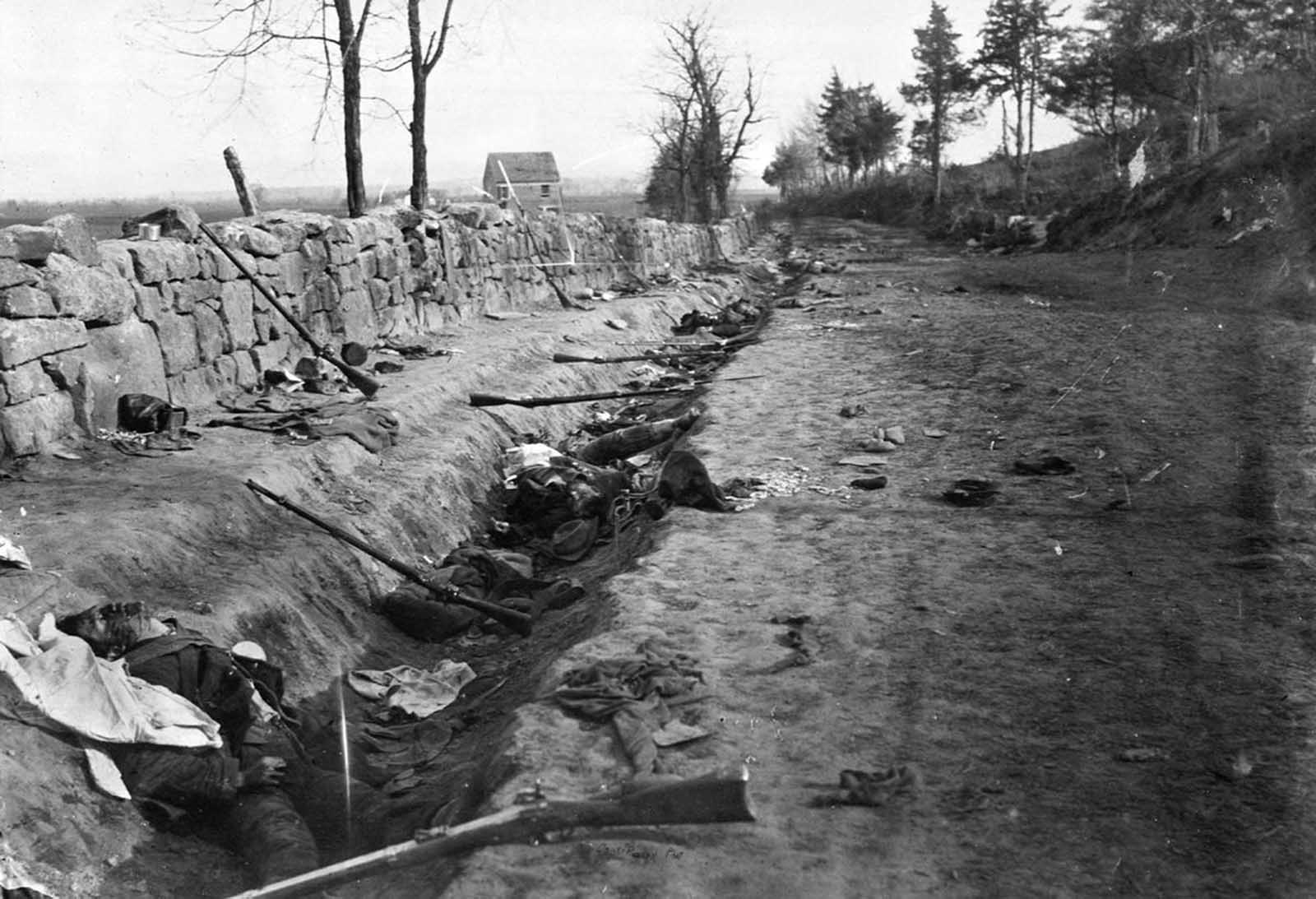
Confederate dead lie among rifles and other gear, behind a stone wall at the foot of Marye’s Heights near Fredericksburg, Virginia on May 3, 1863. Union forces penetrated the Confederate lines at this point, during the Second Battle of Fredericksburg.
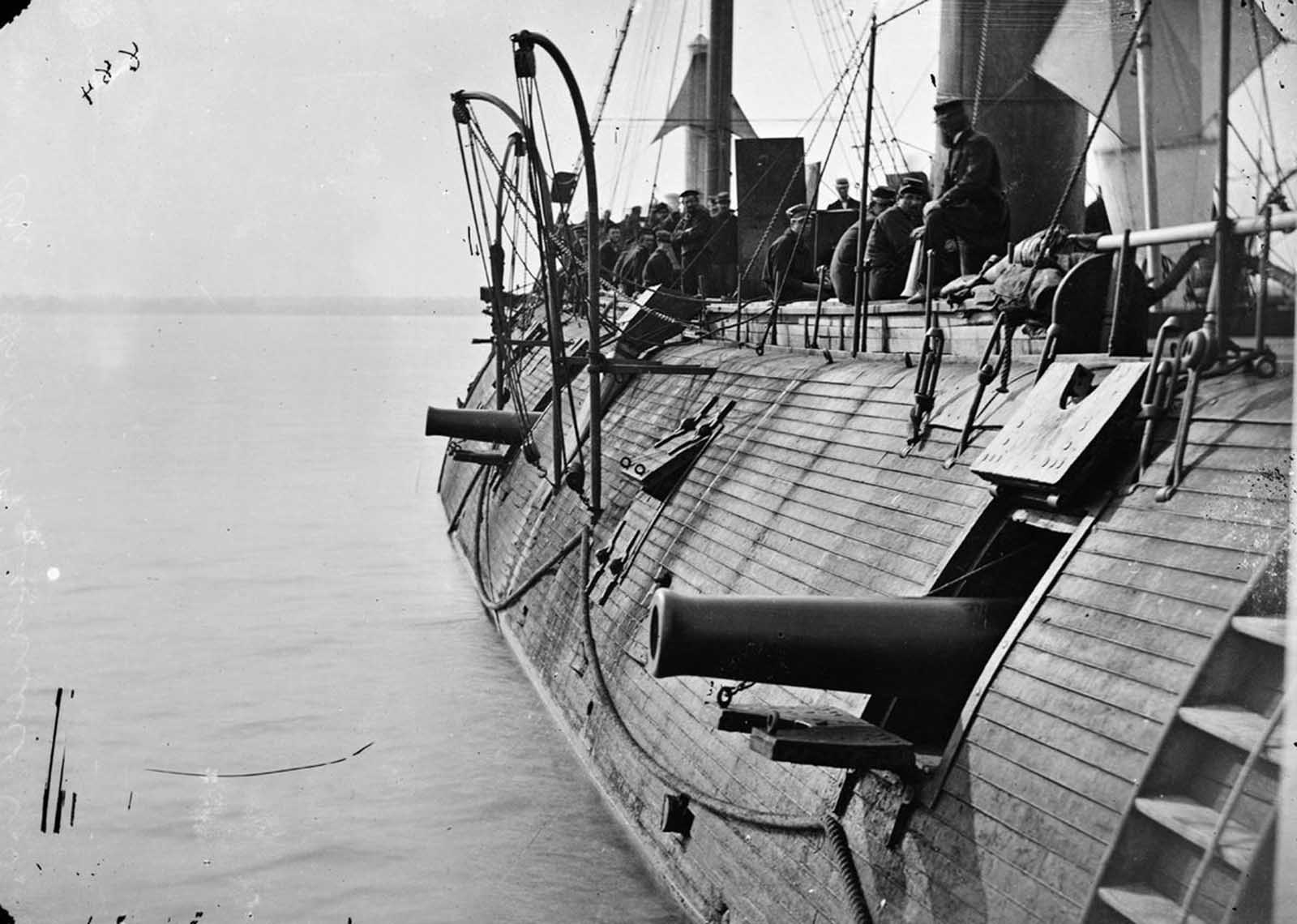
The Federal Ironclad Galena, after recent action with Confederate batteries at Drewry’s Bluff, on Virginia’s James River, ca. 1862.

Interior of a ward of Washington D.C.’s Harewood General Hospital in 1864. Harewood opened in September 1862 and closed in May 1866, after the end of the war.

White House Landing, on the Pamunkey river, Virginia. The site was a major Union Army Supply Base in 1862 ,during the Peninsula Campaign.

A black Union soldier sits, posted in front of a slave auction house on Whitehall Street in Atlanta, Georgia, in 1864. The sign reads “Auction & Negro Sales”.

Rebel fortifications in front of Atlanta, Georgia, in 1863 or 1864.

African Americans collect the remains of soldiers killed in battle near Cold Harbor, Virginia, in April of 1865.
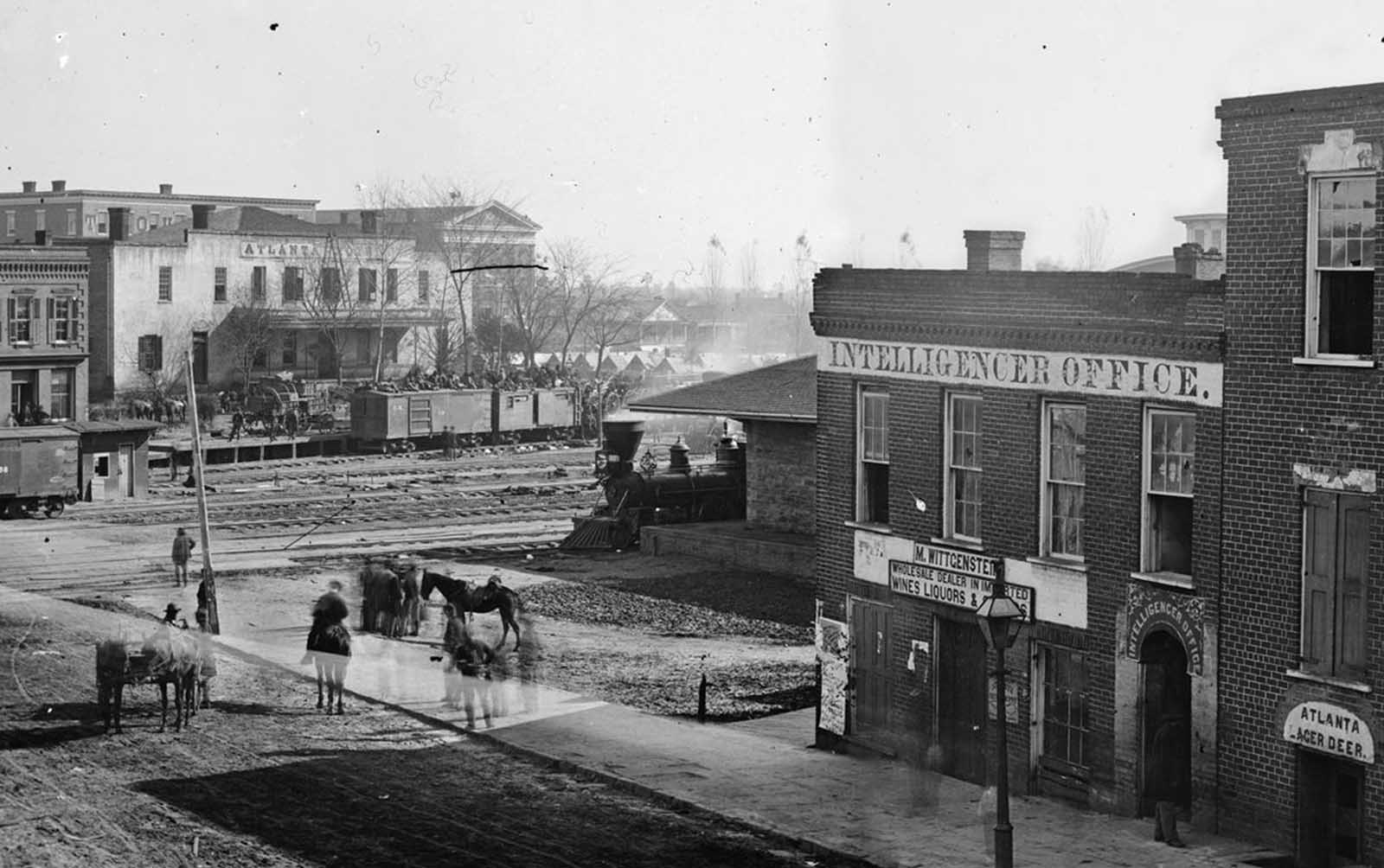
In Atlanta, Georgia, soldiers sit atop boxcars at a railroad depot. At right is the office of Atlanta’s Daily Intelligencer newspaper. Panorama made from two photographs taken by George N. Barnard in 1864.
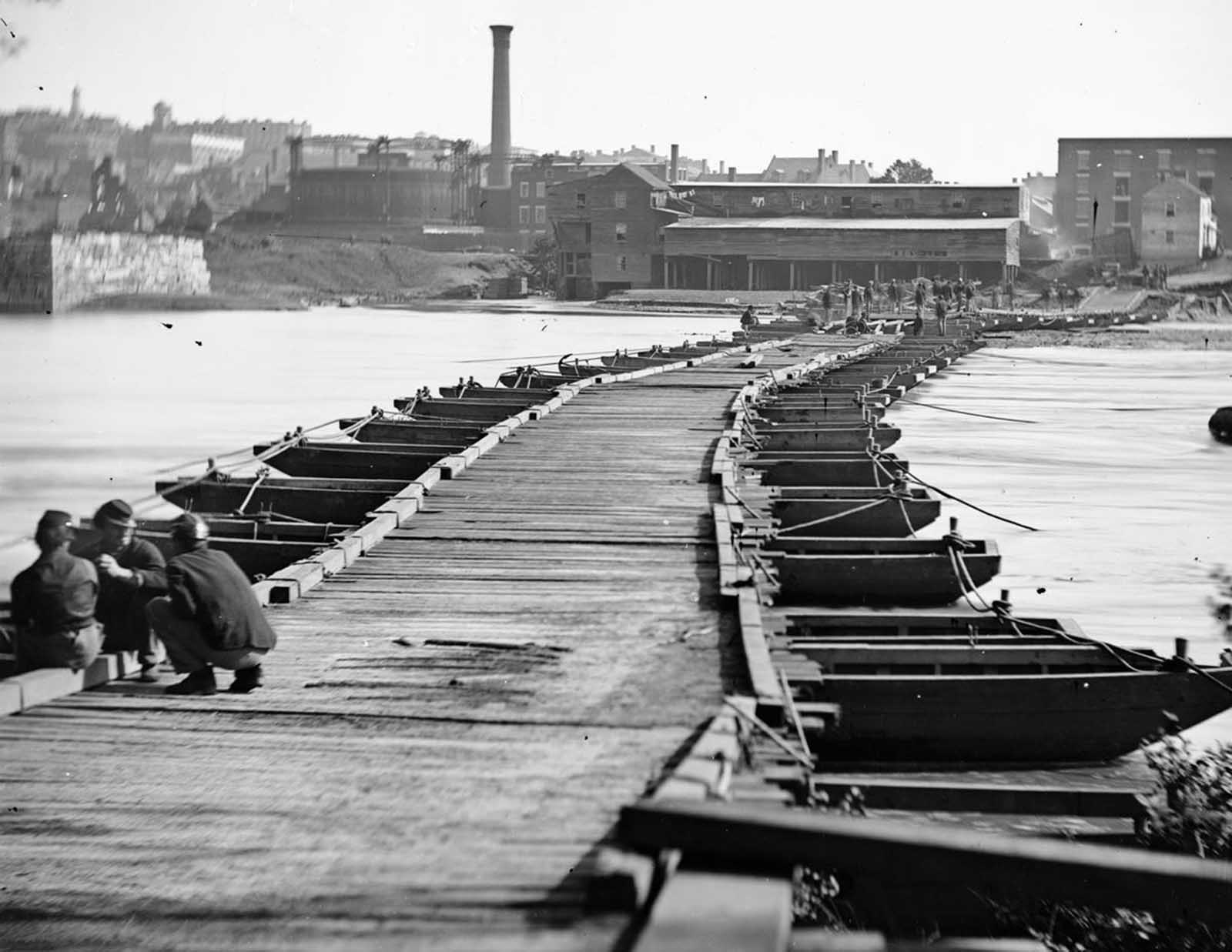
A Pontoon bridge near Petersburg, Virginia, in April of 1865.

The camp of the Tennessee Colored Battery, pictured during the Siege of Vicksburg at Johnsonville, Tennessee, in 1864.
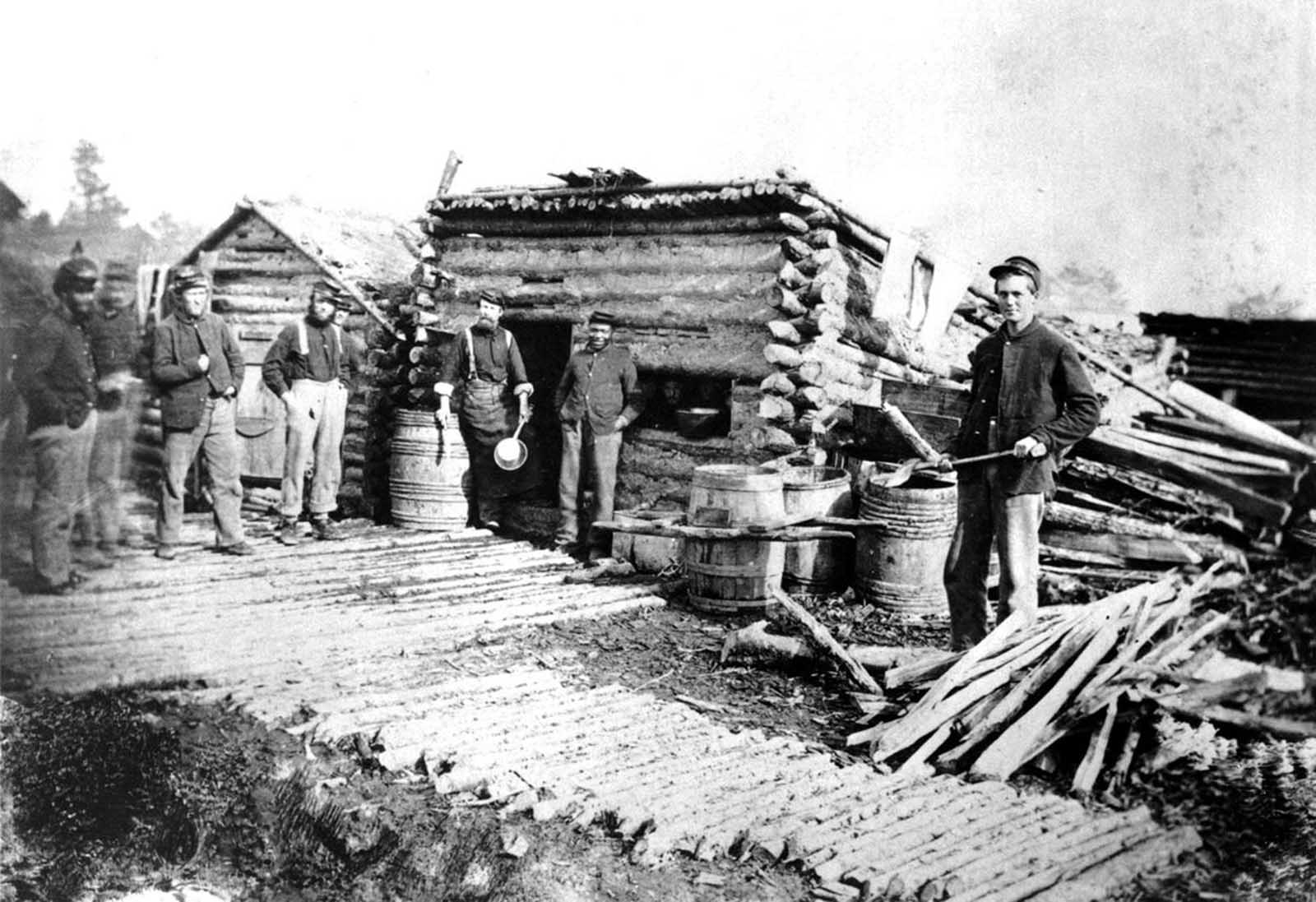
Serving as a soldier in uniform and getting regular army pay, a former slave (center, with hands in pockets) stands with other Federal soldiers at the Army of the Potomac winter headquarters near Fredericksburg, Virginia, The log hut served as a mess house for the regiment.

Bodies of soldiers lie on the ground in front of Dunker Church, after the Battle of Antietam, in Maryland, in September of 1862.

A party of the 50th New York Engineers builds a road on the south bank of the North Anna River, near Jericho Mills, Virginia, on May 24, 1864.
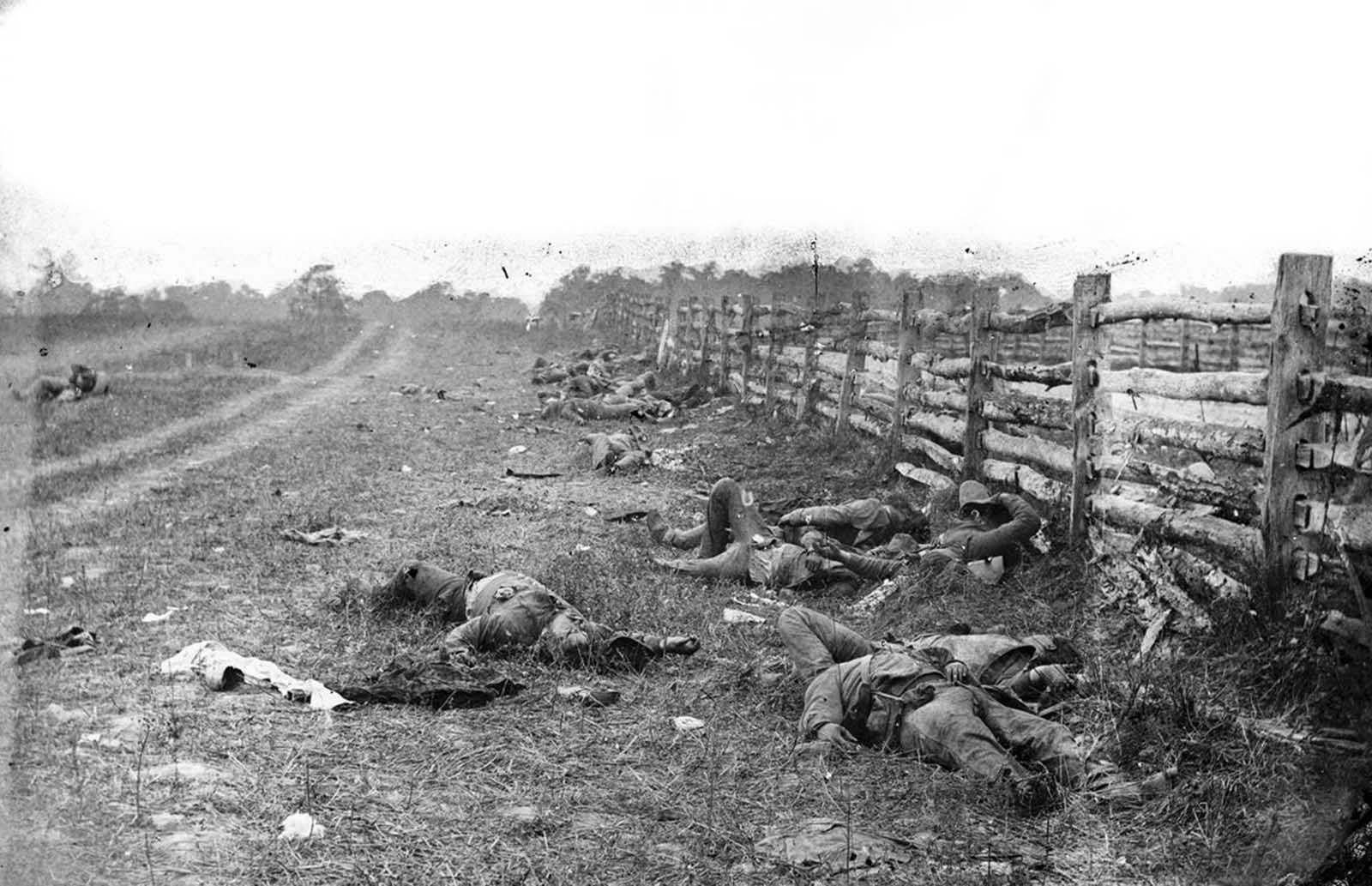
Confederate dead lie strewn near a fence on the Hagerstown road, after the Battle of Antietam, in Maryland, in September of 1862.

A view of the burned district of Richmond, Virginia, and the Capitol across the Canal Basin, in 1865. The city was assaulted by Union forces for more than nine months during the Siege of Petersburg, after which Confederate Gen. Robert E. Lee’s army abandoned the battered city in April, 1865.

The Baptist Church in Fredericksburg, Virginia, photographed from the backyard of the Sanitary Commission depot on May 20, 1864, after the city had been damaged in two different major battles of the war.
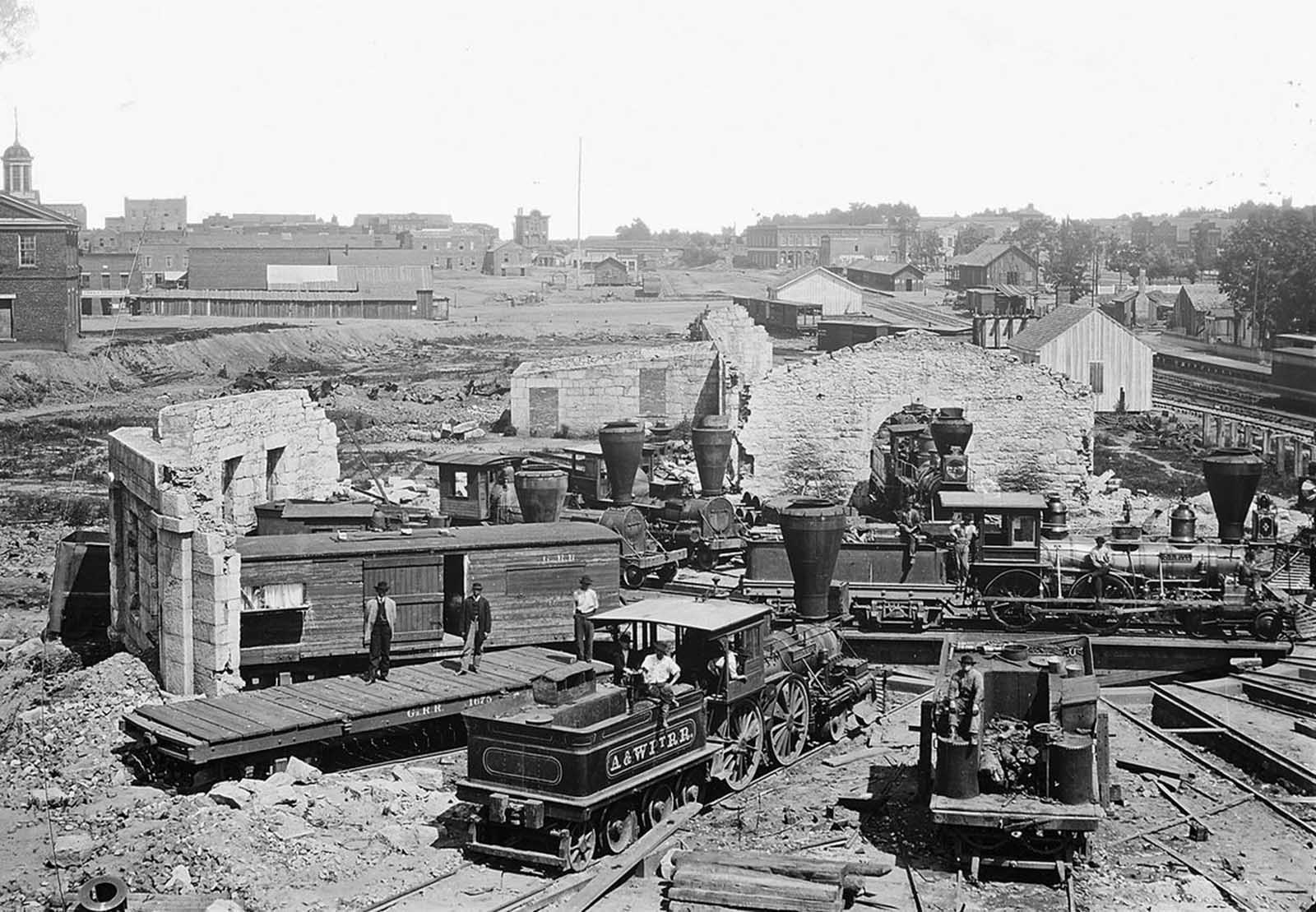
The ruins of an extensively damaged Roundhouse in Atlanta, Georgia after the Atlanta Campaign in the summer of 1864. After Union Maj. Gen. William T. Sherman captured the city, he began his destructive March to the Sea, finally taking the port of Savannah on December 21.
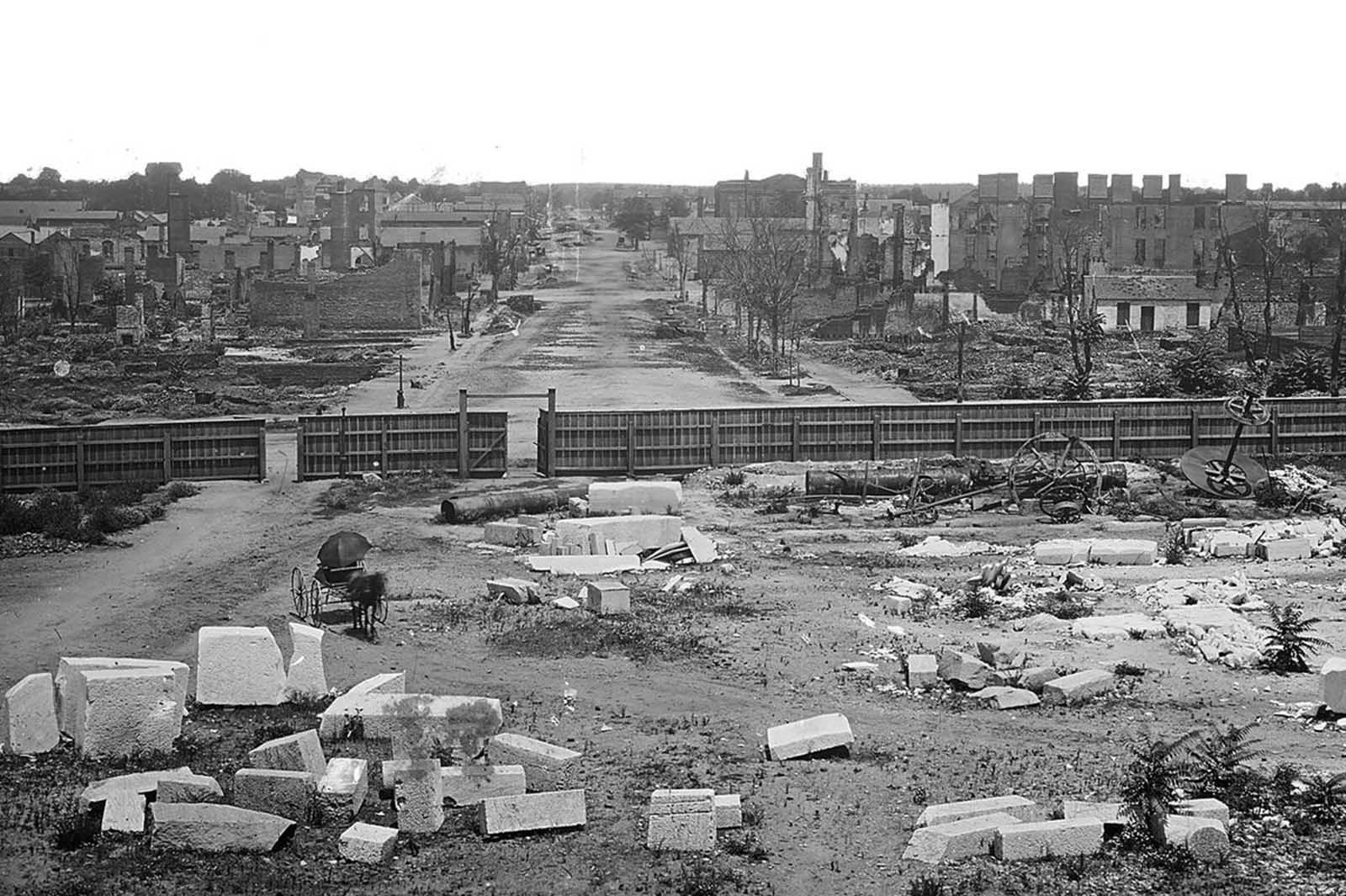
A view of Columbia, South Carolina, seen from the Capitol, following the occupation of the Union Army in 1865 — during which much of the city was destroyed.

Grounds of the destroyed Arsenal with scattered shot and shell in Richmond, Virginia, in 1865.

Residents walk through the ruins of Richmond, Virginia, in April of 1865. Richmond served as the capital of the Confederate States of America during the majority of the Civil War. After a long siege in 1865, with General Ulysses S. Grant’s Union troops about to take the city, Confederate troops were ordered to evacuate, destroying bridges and burning supplies they could not carry. A massive fire swept through Richmond, destroying large parts of the city. About one week after the evacuation of Richmond, Gen. Robert E. Lee surrendered to Grant in near Appomattox, Virginia, on April 9, 1865.
(Photo credit: Library of Congress).


